13 MINUTE READ

What will you read in this blog about Himachal Pradesh architecture? –
- To Start with Some Background
- The Kath Kuni Architecture
- The Temple Architecture
- The Chehni Village
- Wooden Art and Architecture of Himachal
- Dreamy Dalhousie
- Famous Architectural Marvels of Himachal
- Places to Visit in Shimla
- Concluding Lines
To Start with Some Background!
Himachal Pradesh, nestled in the majestic Himalayas, boasts an architectural heritage that reflects its rich cultural tapestry and mountainous terrain. The region’s architecture is a blend of indigenous styles and influences from Tibetan, Buddhist, and Hindu traditions. Characterized by the use of locally sourced stone, timber, and slate, structures here range from ancient temples with intricate wood carvings to traditional homes known as Kath Kuni, built to withstand harsh weather conditions. This article explores the unique design elements, historical influences, and enduring craftsmanship that define Himachal’s architectural identity and its harmonious integration with nature.
Enjoy reading!
The Kath Kuni Architecture
The term ‘Kath kuni’ derives from the Sanskrit words kāshth (wood) and kona (corner), though it is also known locally as kath-kona or kath-ki-kanni in the Sarahan region.
Settlement Patterns

Villages are arranged to follow the natural contours of the landscape, often along sunlit slopes. Typically, structures like homes, shops, and streets are organized around a central temple with open spaces for community events. Often built on the highest ground, Temples serve as focal points and, historically, as watchtowers for surveillance.
Indoor Layout
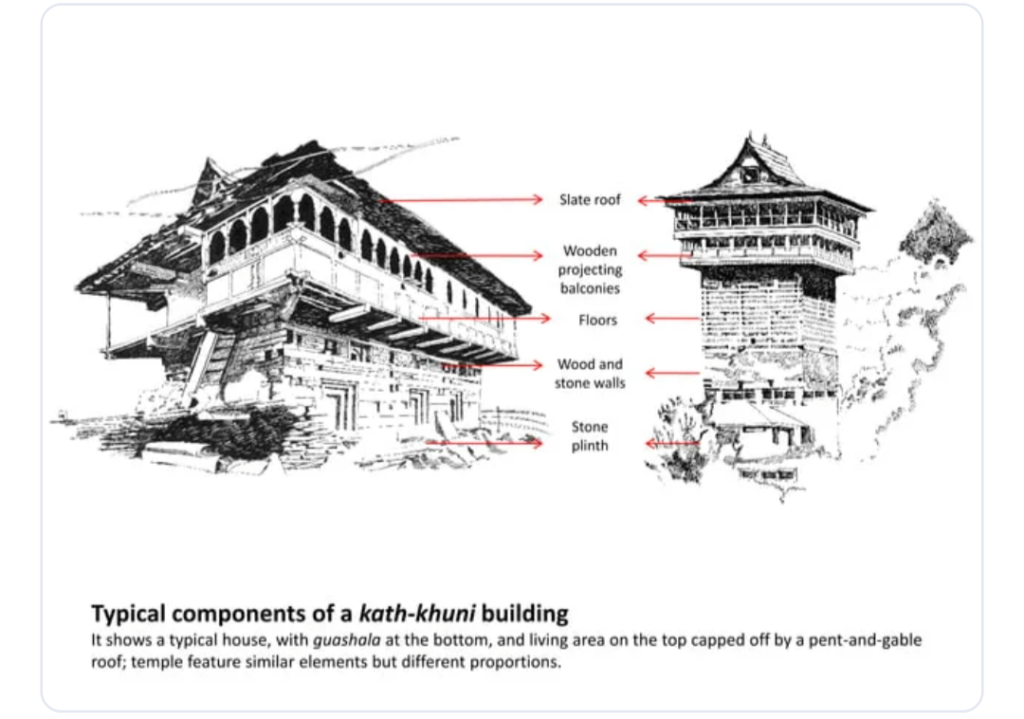


Homes in Himachal Pradesh are generally two to three stories tall, while temples can reach up to seven stories. Each floor serves a distinct purpose: the ground level, or gaushala, houses livestock, the first floor is used for storage, and the upper floors serve as living areas. Staircases connect each level, with some homes having a mezzanine in the gaushala for storing fodder.
Materials and Construction




Constructed largely by hand, these structures utilize local timber and stone. Deodar wood, known for its durability, is commonly used for walls, flooring, and roofing. Stones and wood are layered with interlocking beams at corners for stability. Slate is used for waterproof roofing to endure the region’s heavy rains and snowfall. Foundations consist of a stone plinth, while walls are built with a double-layered design that incorporates stones and mud, with wooden braces for stability.
Climate-Responsive Features
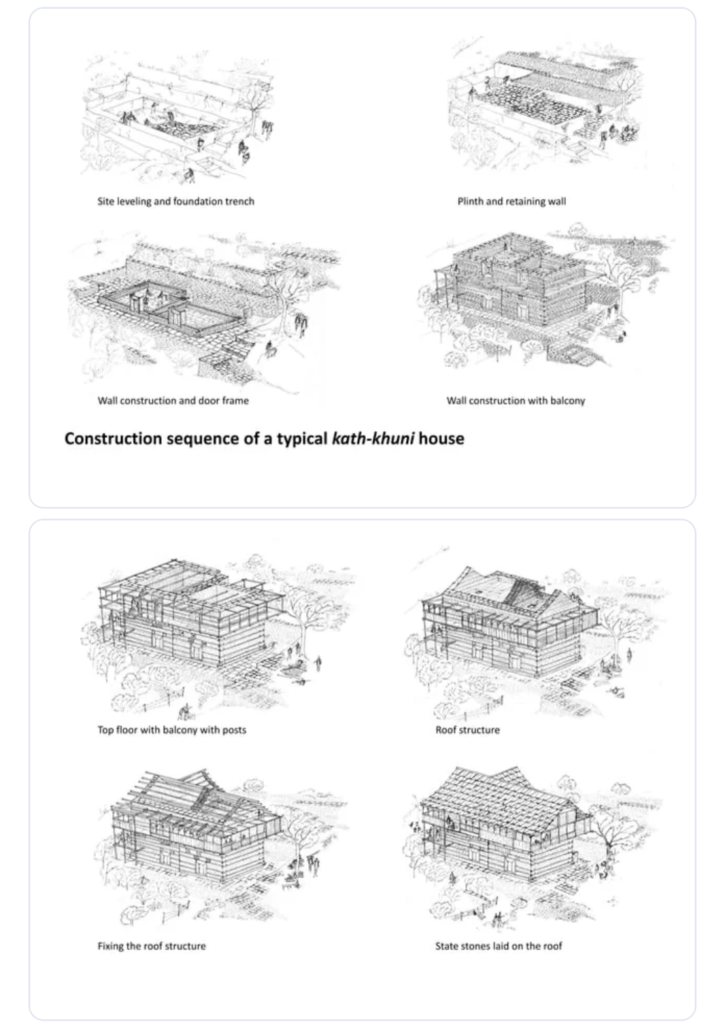
These buildings demonstrate advanced climate adaptation. They face south to capture the winter sun and are oriented to reduce seismic impact. The double-skin wall design insulates against temperature extremes, keeping interiors warm in winter and cool in summer, while also dissipating seismic energy. Roof slopes shed snow efficiently, and the slate material offers frost resistance. Small windows and enclosed balconies help conserve heat. Remarkably, no mortar or nails are used; the weight and interlocking design hold the structure together and allow flexibility during earthquakes.
Functional Spaces
In winter, cattle kept on the ground floor provide warmth that rises to upper living areas. An entire floor is dedicated to storage, keeping essentials accessible during the winter when mobility is limited. The topmost floors, where living areas are located, maximize sunlight and warmth throughout the day, enhancing the home’s resilience and comfort in Himachal Pradesh’s challenging climate.
The Temple Architecture
Himachal Pradesh is home to a diverse array of temple architectural styles, each with unique design elements and cultural influences. Here’s an overview of the primary temple architecture styles in the region:
1. Shikhar Temple Style

Characteristics: Known for tall, conical structures with intricate carvings on the outer walls. They often feature a circular “amalaka” disc at the top.
Elements: Key elements include the Mandap (porch), Shikhar (tower), and Garba Griha (sanctum).
Influence: This style is influenced by Gupta rock-cut temples.
Examples:
- Thakurwada temples in Masrur, Kangra (among the earliest examples of Shikhar architecture in Himachal)
- Lord Vaidyanath Temple in Bajinath
- Laxmi Narayan Group of Temples in Chamba
- Temples in Bajuara
2. Satluj Valley Style

Characteristics: Known for its pagoda-like structures built over the Garba Griha, creating a picturesque effect that blends with the lush surroundings.
Roofing: The roofs are gently sloping and concave, enhancing the visual harmony with the landscape.
Examples: Bhimakali Temple in Sarahan is a prominent example.
3. Dome Temple Style

Characteristics: A newer architectural trend featuring rounded or flattened domes, a style that contrasts with traditional conical or flat-roofed designs.
Examples:
- Brajeshwari Temple in Kangra
- Jwalamukhi Devi Temple in Kangra
- Naina Devi Temple in Bilaspur
4. Freestanding Pagoda Style

Characteristics: Influenced by Buddhist and Chinese pagodas, this style features stacked roofs with diminishing size, often mistaken for Buddhist or Chinese structures from afar.
Examples:
- Hadimba Temple in Manali
- Adi Brahma Temple in Kullu
- Tripura Sundari Temple in Naggar
5. Flat Roofed Style
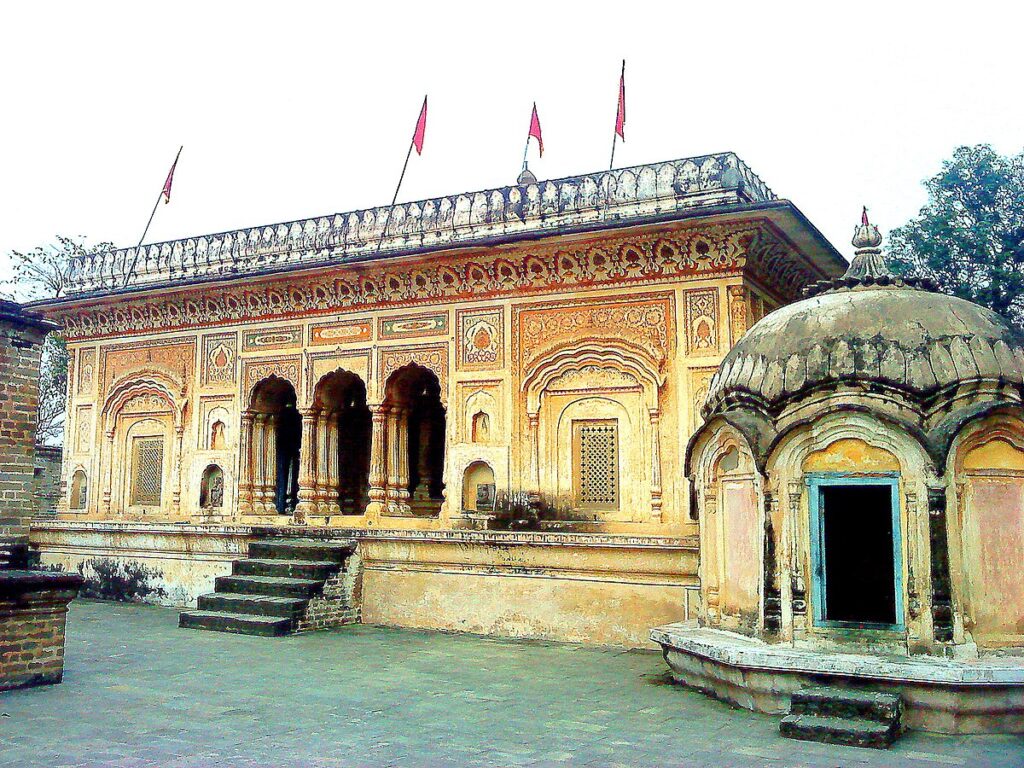
Characteristics: As the name suggests, these temples have flat roofs without any shikhar or dome. This style is rare and mostly confined to Kangra and Hamirpur.
Examples:
- Narbadeshwar Temple in Ajujanpur near Hamirpur
- Ramgopal Temple in Kangra
6. Timber Bonded Style
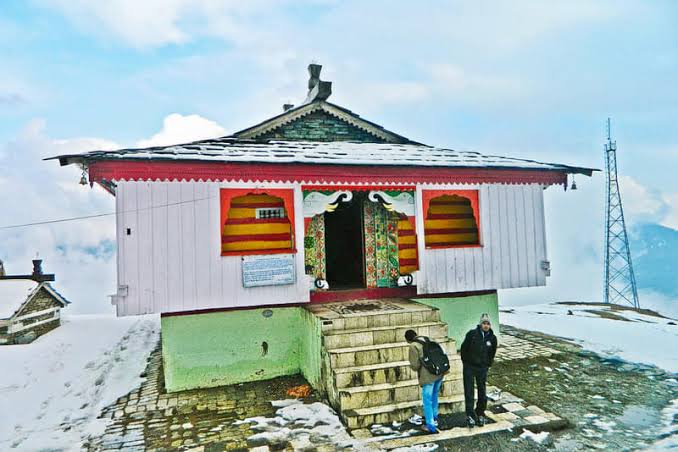
Characteristics: This style leverages local timber, polished to a dark sheen, with temples designed to withstand landslides and heavy snowfall, making them resilient in mountainous terrains.
Examples:
- Bijli Mahadev Temple in Manali (with a pent roof)
- Shakti Devi Temple in Chamba
- Hatkoti Temple in Shimla and Bharmour Temple in Chamba (featuring verandahs)
7. Jubbal Valley Style (Pyramidal Style)

Characteristics: This rare style features a pyramidal roof design, primarily seen in the Jubbal Valley region.
Examples:
- Hateshwari Temple in Hatkoti
- Maha Shiva Temple in Hatkoti
- Shiva Temples in Deora
These temple architectural styles in Himachal Pradesh reflect a blend of regional materials, local climate adaptations, and influences from Buddhist, Gupta, and regional royal patrons, creating a distinct and culturally rich architectural heritage.
The Chehni Village

Chehni Kothi in Tirthan Valley, Himachal Pradesh, is among the few villages where traditional construction methods, such as Kath Kuni, are still practiced. The village layout is typical of Himachal Pradesh, with a nine-story temple tower—once Queen Chaini’s fort residence—at its center. This tower, along with a nearby shorter treasury tower guarded by the village treasurer, showcases the resilience of Kath Kuni architecture, known for its durability against seismic activity.
Derived from Sanskrit, kath kuni combines “kashth” (wood) and “kona” (corner) to describe a technique where wooden beams alternate with stone masonry, avoiding cement and relying instead on the flexibility of dry masonry. A stone plinth elevates these structures, protecting them from snow and groundwater while providing a stable base. Key architectural features include wooden pegs (kadil) for beam stability, truncated stone corners to safeguard wooden edges, and double-skinned walls filled with small stones for insulation and seismic resistance. These elements keep interiors warm in winter and cool in summer, while air gaps help dissipate seismic forces.
The aesthetic appeal of kath kuni structures is striking, with slate-shingled roofs, carved balconies, and intricately decorated columns. Stone and wood textures blend naturally, adding to the visual harmony. Typically, lower levels are used for storage or as cattle sheds, with homes rising to two or three stories and temple towers reaching as high as nine stories.
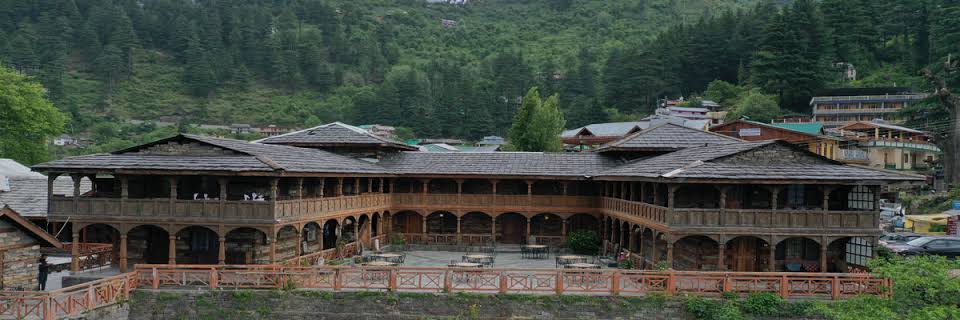
Historical landmarks like Naggar Castle, built over five centuries ago by Raja Sidh Singh, Hidimba Temple in Manali, and the towers of Moorang and Chitkul exemplify Kath Kuni’s longevity, having survived earthquakes and other natural calamities. Local masons’ deep knowledge of the terrain, resources, and climate has been essential to the durability of these structures.
However, as villages turn to concrete and brick for construction, the practice of kath kuni is declining. These newer materials come with high transportation costs, outsourced labor, and a significant ecological impact. Concrete buildings, with their flat or tin roofs, lack the character and harmony of traditional architecture, creating a changing landscape that feels devoid of the grace and spirit of Himachal’s vernacular style.
Wooden Art and Architecture of Himachal
Wood is not only a material choice but it carries symbolic and spiritual significance, embodying divine qualities that are reflected in temple structures. The wooden temples of Himachal Pradesh serve as divine abodes, with intricate carvings that elevate the natural material to a place of religious reverence.
Historically, these temples represent a blend of indigenous and broader Indian architectural styles. Early coin findings with temple-like images suggest that rudimentary religious structures were present in the region from at least the second century BCE, potentially influencing later classical wooden structures that have survived to the present day, such as the Lakshana Devi Temple, Mrikula Devi Temple, and the Shakti Devi Temple.
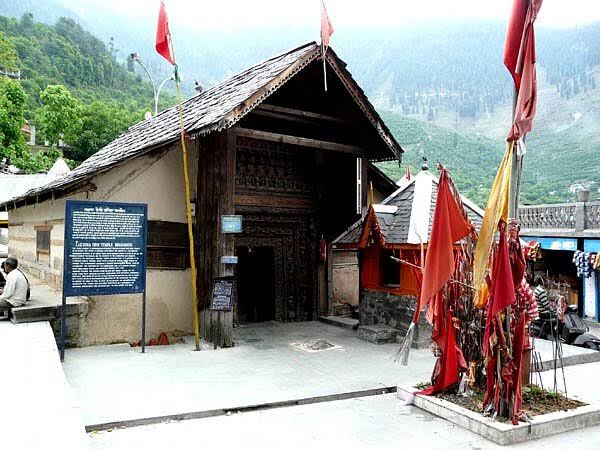
The design of these temples varies according to typologies like the nagara, pent-roofed, and pagoda styles. In particular, the pent-roofed style reflects the climatic adaptations needed for the heavy snowfall and rains of the Himalayan region, incorporating angled slate roofs. These temples also exhibit a unique architectural technique that alternates wood and stone layers, known locally by names such as kath-khuni, which improves structural stability and resilience.
Within the temples, intricate carvings on ceilings, pillars, and doorframes depict mythological figures, floral motifs, and symbolic scrolls, emphasizing the artistry and religious themes integral to Himalayan wooden temple design. This artistry is contrasted with secular architecture in the region, which tends to lack the ornamental woodwork seen in temples, suggesting that the Khash people of the Himalayas reserved their decorative skill primarily for religious monuments.
Wooden temples are therefore emblematic of the Himachali architectural tradition and spirituality, where local deities, often connected to the environment or folklore, occupy an honored place in the folk pantheon.
Dreamy Dalhousie
Dalhousie, nestled in the lap of the Himalayas, is a beautiful hill station in Himachal Pradesh known for its colonial charm, scenic beauty, and rich history. Named after Lord Dalhousie, the British Governor-General of India in the 19th century, the town is spread across five picturesque hills: Kathlog, Potreys, Tehra, Bakrota, and Bolun. Here’s what makes Dalhousie a captivating destination for travelers and architecture enthusiasts alike:
1. Colonial Architecture and Historic Churches
Dalhousie showcases an impressive blend of colonial-era architecture, with beautiful old buildings, charming bungalows, and iconic churches. Notable among these is St. John’s Church, the oldest church in Dalhousie, built in 1863, and St. Francis’ Church with its intricate glasswork and charming interiors.
These churches not only reflect the architectural style of the British Raj but also serve as peaceful retreats within the town’s lush surroundings.

2. Mesmerizing Forest Trails
The forest trails in Dalhousie wind through groves of pine, deodar, oak, and rhododendron, creating a serene and picturesque landscape.
These trails offer opportunities for peaceful walks, nature photography, and birdwatching, with some paths leading to waterfalls, springs, and rivulets that enhance the charm of this hill station.
3. Vistas of the Ravi River
The Ravi River, with its winding course through the mountains, can be seen snaking like a “silver snake” from various viewpoints around Dalhousie.
This natural spectacle, coupled with views of the surrounding woodlands, adds to the town’s tranquil appeal, providing unforgettable scenic moments for visitors.
4. Spectacular Views of Chamba Valley and Dhauladhar Range
Dalhousie offers panoramic views of the Chamba Valley, with its sprawling green fields and rustic charm, and the Dhauladhar range, renowned for its snow-capped peaks.
These awe-inspiring vistas are best appreciated from higher vantage points around Dalhousie, particularly on clear days when the mountain range fills the horizon.
5. Influence of Tibetan Culture
Tibetan culture adds an exotic touch to Dalhousie, evident in the large Tibetan population and their unique cultural markers throughout the town.
Along the roadsides, visitors can spot huge rocks intricately carved in Tibetan style and painted in vibrant colors, showcasing Tibetan art and Buddhist symbols.
6. Accessibility
By road, Dalhousie is well-connected, lying 555 km from Delhi and 45 km from Chamba. The closest railway station is Pathankot, 85 km away, making Dalhousie relatively accessible for those traveling from nearby regions.
Dalhousie, with its blend of natural beauty, colonial charm, and Tibetan influence, offers a peaceful retreat where one can appreciate the architecture of the past alongside breathtaking landscapes. Whether it’s strolling through forest trails, gazing at the Ravi’s winding path, or marveling at the majesty of the Dhauladhar range, Dalhousie remains a timeless haven for explorers and architecture lovers alike.
Famous Architectural Marvels of Himachal
1. Viceregal Lodge

Location: Shimla
Style: English Renaissance meets Victorian
Notable Features: Built in 1888, served as the summer residence for the British Viceroy and later as Rashtrapati Nivas. Now the Indian Institute of Advanced Study. The use of local sandstone gives it a distinct grey look, and the structure features arches, columns, mullioned windows, and lavish teak interiors with Kashmiri walnut ceilings.
2. Tabo Monastery

Location: Lahaul and Spiti district
Heritage: Founded in 999 A.D. by Buddhist King Yeshe O’d; a UNESCO World Heritage Site
Notable Features: Made of mud and brick, the complex includes chapels, stupas, and meditation caves. Its paintings blend Indian and Tibetan influences, giving the monastery a unique spiritual character.
3. Hidimba Devi Cave Temple

Location: Manali
Style: Wooden Pagoda
Notable Features: Built on a large rock surrounded by deodar trees, this temple dates back to the Mahabharata period. It is entirely constructed of wood with a tall, pagoda-style roof adorned with Buddhist motifs, and the base combines mud and stone using vernacular construction methods.
4. Masroor Rock Cut Temples
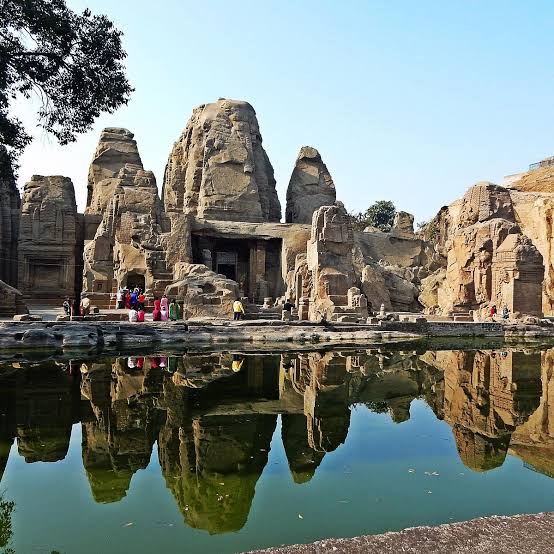
Location: Kangra district
Style: Indo-Aryan, Nagara style
Notable Features: Monolithic temples carved from sandstone, showcasing ancient Nagara-style temple architecture. Featuring carved lotus patterns on the mandapas, the complex was left incomplete, and much of the original art has been damaged by earthquakes.
5. Kangra Fort

Location: Kangra
Style: Mixed (Granite construction with diverse cultural influences)
Notable Features: As the largest and possibly the oldest fort in the Himalayas, Kangra Fort has witnessed multiple invasions by Sultanates, Mughals, and Sikhs. It features high walls and ramparts, several temples, and showcases a fusion of architectural styles from various rulers, giving rise to unique Kangra art.
6. Kalka Shimla Railway Line

Location: Spans 96 km between Kalka and Shimla
Heritage: UNESCO World Heritage Site
Notable Features: A British-era narrow-gauge railway line with 18 stations featuring gabled timber structures. The stations blend British and Indian architectural elements, set amid scenic Himalayan valleys.
Places to Visit in Stunning Shimla
Shimla, one of India’s most picturesque hill stations, is a treasure trove of natural beauty and architectural wonders. Here’s a guide to some of Shimla’s most captivating spots, each offering a unique blend of natural charm, history, and colonial-era architecture:
1. The Ridge of Shimla

A central, open space for cultural events, The Ridge offers spectacular views of snow-capped mountains. It’s home to Christ Church, a Neo-Gothic marvel built in 1844, and a 1910 Tudor-style library. Below the Ridge are historic water tanks, an engineering feat that has provided water to Shimla since the British era.
2. Mall Road

Mall Road is Shimla’s pedestrian-friendly social hub, filled with shops, cafes, and landmarks like the Gaiety Theatre. This area’s architecture blends colonial and traditional styles, with vibrant facades and roofed windows that create a lively ambiance.
3. Jakhoo Hill and Temple

Shimla’s highest peak, Jakhoo Hill, is home to Jakhoo Temple, dedicated to Lord Hanuman. Surrounded by alpine and deodar trees, it features a towering Hanuman statue and offers stunning views of the Shivalik ranges.
4. Christ Church

Built in 1857 in the Neo-Gothic style, Christ Church is known for its height and stained glass windows that symbolize virtues like hope, faith, and courage. It also houses India’s largest pipe organ and is beautifully illuminated at night.
5. Viceregal Lodge

Also known as Rashtrapati Niwas, this grand English Renaissance-style building was the former summer residence of the British Viceroy. Now the Indian Institute of Advanced Study, the lodge showcases teakwood interiors and offers scenic views from Observatory Hills.
6. Tara Devi Temple

This 250-year-old temple atop Tara Parvat combines Pahari architecture with intricate carvings by local artisans. It’s surrounded by oak and rhododendron forests and provides breathtaking views of the surrounding Himalayas.
7. Kali Bari Temple

One of Shimla’s oldest temples, Kali Bari Temple was built in 1845 to honor Goddess Kali (Shyamala). Its distinct blue-colored idol of the deity is an architectural and spiritual highlight.
8. Himachal State Museum

This colonial-era mansion houses exhibits on Himachal’s cultural heritage, including Pahari paintings, ancient bronzes, masks, and a vast library reflecting India’s historical diversity.
9. Kalka-Shimla Toy Train

The UNESCO-listed Kalka-Shimla Toy Train offers a journey through the mountains, covering 96 km with 103 tunnels and countless scenic views of pine-covered hills and twisting valleys.
10. Annandale

A scenic flatland used historically for British sporting events, Annandale now hosts an Army Museum and offers lush views of oak and deodar forests.
11. Kuthar Fort
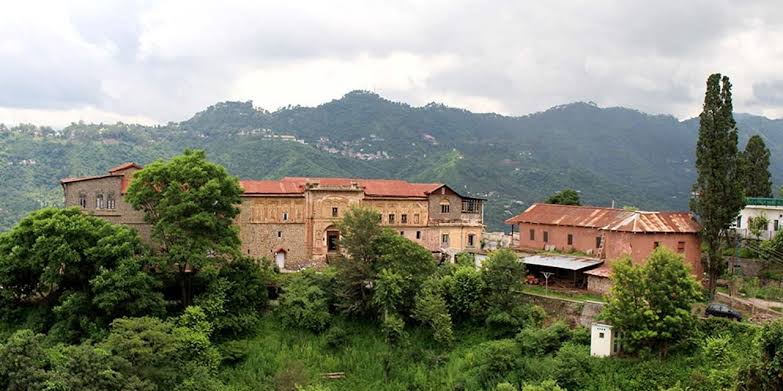
Over 800 years old, Kuthar Fort showcases Rajasthani-inspired architecture with intricate wooden carvings and a freshwater supply system. Now a resort, it offers panoramic views of surrounding hill stations like Kasauli and Kunihar.
12. Lakkar Bazaar

Famous for wooden crafts, Lakkar Bazaar is a bustling market with antique shops and wooden artifacts. Known for its unique wooden toys, it’s a must-visit for collectors and art lovers.
13. Gaiety Heritage Cultural Complex

Built in 1887, this cultural center hosts performances and art exhibitions in a Gothic Revival-style setting. It was once part of Shimla’s Town Hall and remains a symbol of the city’s artistic legacy.
14. Kufri

Known as the “Switzerland of the East,” Kufri offers ski runs, hiking trails, and the Kufri Fun World amusement park, one of the highest in the world. The adjacent Water Catchment Wildlife Sanctuary is home to diverse flora and fauna.
15. Gorton Castle

Built in 1904, Gorton Castle features Neo-Gothic architecture with a fairy-tale red iron roof. Its Andaman-sourced wooden blocks, Sanjauli greystone, and intricate Rajasthani jalli work make it an iconic landmark.
These spots in Shimla reflect the blend of natural beauty and historical charm that continues to captivate visitors. Whether you’re exploring its temples, heritage sites, or scenic hills, Shimla offers an unforgettable journey through India’s architectural and cultural landscape.
The Concluding Lines!
The architecture of Himachal Pradesh is a captivating blend of history, nature, and artistry, embodying influences from Hindu temples, Tibetan monasteries, and British colonial structures. Towns like Shimla and Dalhousie showcase neo-Gothic churches, Victorian-era mansions, and elegant woodwork that harmonizes with the natural landscape. Iconic structures such as the Viceregal Lodge, Gorton Castle, and the Gaiety Theatre reflect British architectural grandeur, while temples like Tara Devi and Jakhoo embrace indigenous styles, with intricate carvings and traditional craftsmanship. Together, these architectural gems offer a glimpse into Himachal’s layered heritage, making the state an enchanting journey through cultural and architectural legacy.
References
- Wikipedia.org. (n.d.). Kath Kuni Architecture. [online] Available at: https://en.wikipedia.org/wiki/Kath_kuni_architecture#:~:text=Typical%20houses%20in%20Himachal%20are,or%20ornamentation%20and%20detailing%20varies
- Sood, Rishika. (n.d.). The Heritage Architecture of Himachal Pradesh. [online] Available at: https://www.re-thinkingthefuture.com/rtf-fresh-perspectives/a1341-the-heritage-architecture-of-himachal-pradesh/
- Abhyankar, Shoma. (April 11, 2023). Himachal Pradesh: A look at the traditional architectural legacy of the state. [online] Available at: https://www.architecturaldigest.in/content/himachal-pradesh-traditional-kath-kuni-architecture/
- Chougula, Shivani. (n.d.). Kath Kuni Architecture of Himachal Pradesh. [online] Available at: https://www.kaarwan.com/blog/architecture/kath-kuni-architecture-of-himachal-pradesh?id=704
- Modgil, Chandramolle. (n.d.). Wooden Art and Architecture of Himachal Pradesh. [online] Available at: https://www.sahapedia.org/wooden-art-and-architecture-of-himachal-pradesh
- himachalonline.in. (n.d.). Architecture of Temples in Himachal Pradesh. [online] Available at: https://www.himachalonline.in/guide/architecture-of-temples-in-himachal-pradesh
- Samarth, Ayushi. (n.d.). 15 Places to Visit in Shimla for Travelling Architects. [online] Available at: https://www.re-thinkingthefuture.com/travel-and-architecture/a8064-15-places-to-visit-in-shimla-for-travelling-architect/#google_vignette
- hpchamba.nic.in. (n.d.). Dalhousie. [online] Available at: https://hpchamba.nic.in/tourist-place/dalhousie/
![]()